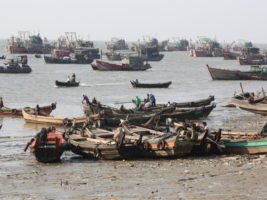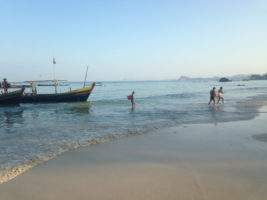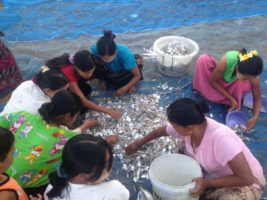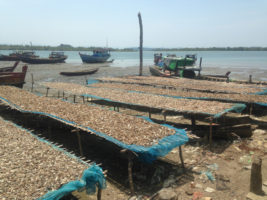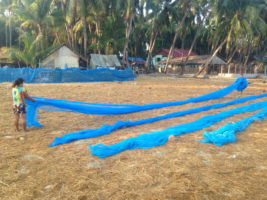Thriving Marine Fisheries in Myanmar: Advancing and building a pipeline of support and capacity for marine conservation and fisheries sustainability
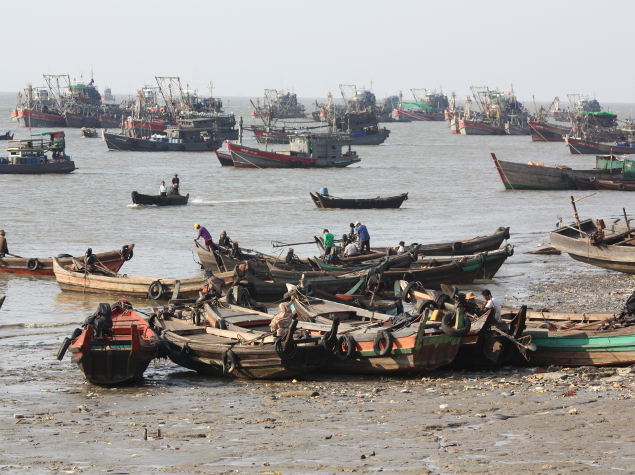
Myanmar’s fisheries and marine ecosystems face numerous threats, including overfishing, a lack of protections for critical habitats and species, and lack of management capacities. Inshore fisheries (largely defined as those within 5-10 nautical miles from shore) have dramatically declined in the last ten years, putting local communities that rely heavily on fishing for livelihoods and overall food security at risk.
To reverse this trend, better fishing and marine conservation policies and practices are urgently needed. Interventions must address the lack of experience and capacity in fisheries management, the dearth of data and information, and the need for community-based fishery management organizations. Fortunately, among fishermen, government, and community leaders there is an eagerness to set Myanmar on course to recover its fisheries, protect coastal ecosystems, and sustain healthy communities.
Environmental Defense Fund (EDF) began conducting an initial scoping in Myanmar and in the Gulf of Mottama (GoM) to identify pilot sites for inshore fisheries reforms in March 2016. The GoM region has habitat that is still relatively healthy. With the right policies, its fisheries and biodiversity could rebound to their once abundant state. The NGO identified 3 pilot sites that could be transformed to high-performing fisheries that model the benefits of reform and serve as proof points and learning laboratories that will inspire replication and scale throughout Myanmar. This project is part of a broader one, the Gulf of Mottama Project (GoMP), implemented by a coalition of international and local NGOs, government, academia and fisher community groups in 60 communities.
The project sites encompass three Mon State communities along the Gulf of Mottama (Aung Kan Thar, Zoke Ka Li, and Baing Laung villages) that are highly dependent on fisheries.
Among the three communities identified for this project, there are an estimated 750 fishermen and a further 4,500-5,000 people involved in the fisheries sector, a significant portion of whom are women involved in business management and post-harvest processing. The main target species in this region are croakers, threadfin, crabs, mangofish and hilsa.
Overall objective:
This project will help to restore fish populations to previous abundance that contribute to healthy ocean ecosystems and reduce poverty among inshore fishers.
In recognition of the ecological importance of this area, there is an ongoing process to institute the GoM as a wetland of international importance under the Ramsar Convention on Wetlands, through support from the Community-led Coastal Management Initiative.
Planned initiatives:
- Conserve marine ecosystems, habitats, and biodiversity: EDF will review available literature, collect data to better understand the biological, ecological, social and economic factors that will influence the recovery of the fisheries and strengthening of communities. They will also study the factors involving women and ethnic minority groups.
- Improve local livelihoods through increased fisheries productivity and value.
- Strengthen capacity in Myanmar for the local management of living marine resources: EDF will work with local partners to establish and support community-based co-management committees that will build stewardship by fishermen to protect their fishing grounds.
- Facilitate the understanding and application of sustainable fisheries management.
- Increase social and ecological resilience to climate change: EDF will support Myanmar institutions by providing education, training, and capacity building so that local institutions are able to fully participate in the management and oversight of their fisheries.
Final summary report:
Over the implementation period, EDF provided 7 trainings on fisheries management to hundreds of stakeholders through workshops and 3 community-based trainings. A model was built and trialed for the offshore fishery (including seasonal closures with adjustable levels of fishing effort, compliance with regulations, and climate change parameters) and was presented to the government, industry and NGO partners.
4 sets of trainings focusing on the fundamentals of data collection and fisheries management were held for the Golf of Mottama Project (GoMP) consortium, NGOs, Department of Fisheries (DoF), community fisheries leaders and committees and universities, for a total of 95 people. A mapping of each of the 3 targeted communities’ systems was conducted and all targeted communities have been advocating the DoF for illegal gear enforcement, who has responded so far with increased enforcement actions.
Villagers in all 3 target communities are now aware of patrolling activities and perceive increases in catch, which they attribute to the reduction in illegal fishing. Through the partnerships and capacity building for the GoMP and the University of Mawlamyine, fisheries data have been collected and analyzed for all the target communities. All 3 target communities have now active co-management committees and the fishing grounds near Aung Kan Thar established a co-management area that is recognized by Mon State.
More than 50 community members from all 3 communities were trained in fisheries management and all 3 communities have organizations with the capacity to participate in co-management of fisheries. EDF led 13 Mon State workshops/trainings for more than 150 participants, including DoF staff, community members, NGO staff, university students and faculty to sensitize and motivate influential change agents.
The GoMP will continue to advance sustainable fisheries management through the network of technical partners who can support ongoing capacity building and will be sharing lessons and approaches across the approximately 60 communities they work with, thereby creating the structure for replicating solutions locally.





